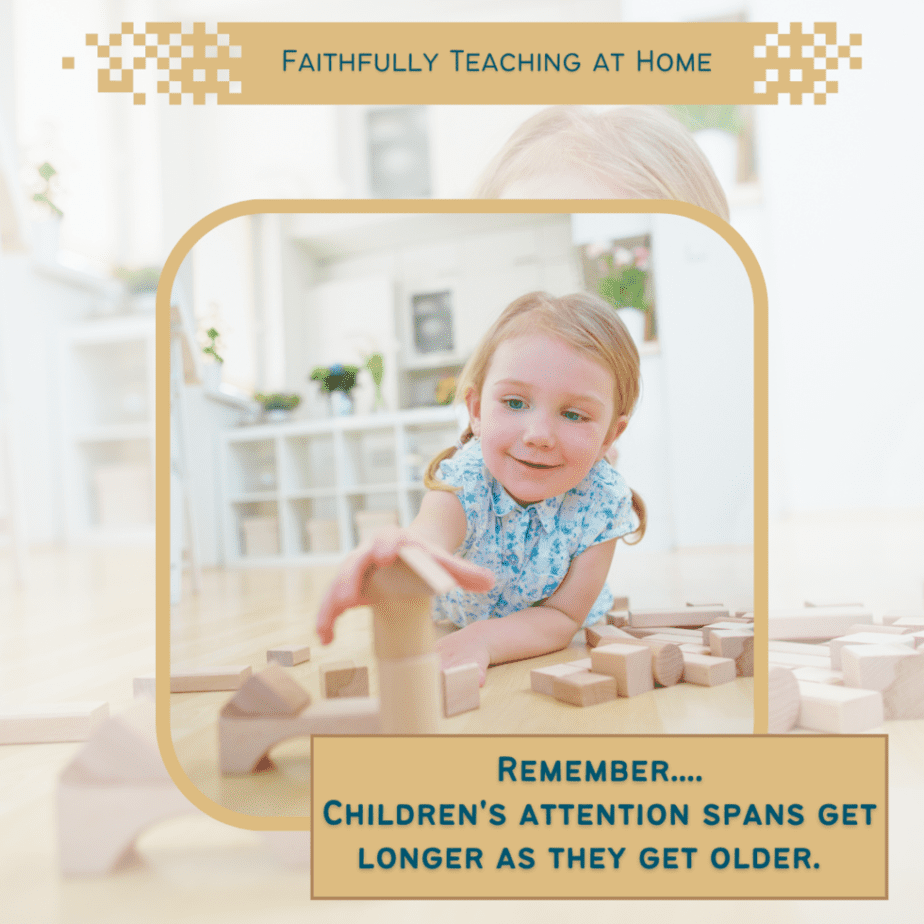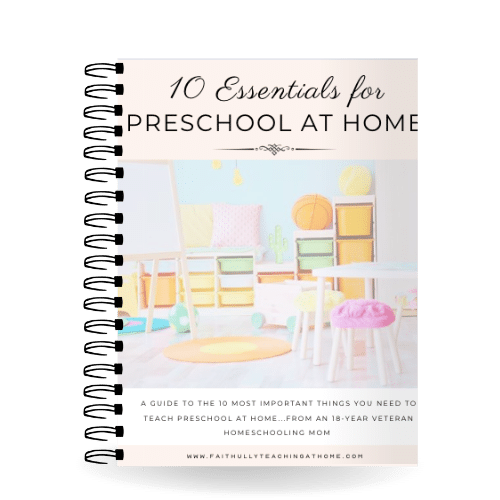Activities to Increase Attention Span

Activities to Increase Attention Span
One skill that most preschoolers need to work on is longer attention spans. And it does take time because this is a developmental issue, not a disobedience issue. Read on to find out why and for 8 activities to increase attention span in young children.
What is attention span?
Attention span is the length of time that a child can pay attention on one topic or one task without becoming distracted. To clarify, this time span varies depending on age, gender, environment, and different abilities, just to name a few.
- Age – The older you get, the longer your attention span gets. This is purely developmental. For instance, you cannot expect a 2-year old to have the same attention span as a 4-year old. Physically, it just can’t be done.
- Gender – Girls’ attention spans are longer than boys.
- Environment – The more distractions surrounding a child, the longer it may take to develop a longer attention span. Distractions such as loud noises, TV, video games, radio, or basically any kind of sounds can be a distraction for some children.
- Different Abilities – This includes learning abilities, mood disorders, cognitive abilities, any mental health issues
- Biological Needs – Attention spans can vary depending on hunger, thirst, lack of sleep, and sickness or pain. For instance, sleep apnea can cause your child not to focus, which I found out from my child’s doctor when she was diagnosed with sleep apnea due to enlarged tonsils.
Have you ever noticed how a toddler will start once activity, for instance, a puzzle. First, he will put one piece in the puzzle then run to play with some Hot Wheels. Next after playing with the cars for a couple of minutes, he decides he wants to look at a book, and so on. Sometimes you feel like you could get whiplash from the way toddlers move from activity to activity in a matter of minutes!
Toddlers have pretty short attention spans. As they get older, you will notice they stay a little bit longer at an activity. They may finish half the puzzle before moving to another toy. Instead of stopping you after 2 pages of a board book, they will let you read half the book or even the whole thing.
Why is attention span important?
Attention span is important for several reasons. Most importantly, the most crucial reason is that it is necessary for a child’s learning. A child needs to be able to focus on a lesson from start to finish to understand new information. If a child can only focus for the first half of a lesson, she could miss the most important part of it.
Another reason is completing a task. Without a developed attention span, children can’t finish jobs that they have been given. Think of the accomplishment you feel as you complete a task, and the confidence you get when you finish a new kind of project! A child who cannot complete a task will not be able to feel those positive emotions and feel capable.

Remember, attention spans get longer as a child gets older!
It bears repeating: you can’t expect a young child to have a long attention span. It’s just physically impossible. I’m sure there are some young children out there who have amazingly long attention spans that defy this physical development rule, but for the most part, it holds up to be true. A 2-year old’s attention span for one task is 4-6 minutes on average. A 4-year old’s attention span is 8-12 minutes! See the difference just two years makes?
If you are concerned that your child cannot focus for very long, try some of the 8 activities to increase attention span in preschoolers below.
Age range of attention span
If you look up attention span charts, you will find a variety of times. Some experts say that attention span averages 2 minutes per year of child. On the other hand, other experts feel like it’s closer to 5 minutes per year. I personally feel, after parenting 4 kids, that 5 minutes per year of a child’s age is too much.
Here is the most common chart I found while researching:
- 2 years old: 4-6 minutes
- 3 years old: 6-8 minutes
- 4 years old: 8-12 minutes
- 5 years old: 10-14 minutes
- 6 years old: 12-18 minutes
- 8 years old: 16-24 minutes
- 10 years old: 20-30 minutes
- 12 years old: 24-36 minutes
- 14 years old: 28-42 minutes
- 16 years old: 32-48 minutes

Does technology have a negative impact on attention span?
Unfortunately, there have not been many studies done on attention span and technology. Microsoft did a 2015 study on attention span while online. But it focuses on our attention spans online, not on everyday tasks. Yet there are personal stories of people who feel that technology does have a hand in shortening attention spans. This college professor, Dr. Cynthia King, states that she cannot keep her students attention for more than 5-10 minutes before they feel compelled to check their phones. As children nowadays receive smart phones earlier than ever, this is something to keep in the back of your mind.

Can my child do activities to increase attention span?
Certain activities can help practice lengthening your child’s attention span. Even if your child has a good attention span right now, it won’t hurt to do some of these activities.
8 Activities to Increase Attention Span
- Board Games – Start with shorter board games to make sure your preschooler can finish a game. But if he can’t, just wait and try again later. Games like Candy Land, Chutes & Ladders, and Hi Ho Cherry-O are great for preschoolers.
- “I Spy with My Little Eye…” Game – This is an easy game that requires no materials and can be done anywhere! It helps kids focus on their environment.
- Puzzles – Make sure you don’t choose a puzzle that is too hard for your child. Sometimes you can’t go by the age ranges either. Some of my kids weren’t great at puzzles and took longer to “promote” up to harder puzzles. But puzzles do require focus, and a complete puzzle is a great visual reward for a job well done!
- Memory Games – Memory games help improve focus in a fun way.
- Reading Aloud to Your Child – Reading aloud to your child itself has so many benefits already. In addition, an added benefit is that it will slowly increase your child’s attention span. Start with easy, short picture books. When your preschooler starts asking for more and more books in one sitting, start reading longer picture books. Work up to short chapter books. Yes, some preschoolers can sit still for short chapter books that they find interesting! It won’t happen overnight though, so don’t be disappointed if he can’t sit still that long at first.
- Timer – If used correctly, a timer can help. Time you child doing a certain activity a couple of times to get a good idea of how long he can focus on that activity. Then the next time he wants to do that activity, tell him you are going to time him and see if he can work on it for “x” amount of minutes. Set the timer for 1 minute more than the average time he spent the time before. For example, if he usually spends around 5 minutes playing with puzzles, see if he can spend 6 minutes when timing it. If he complete 6 minutes, give him lots of praise! Then the next time, try 7 minutes. However, don’t time every single activity or time it every single time. The timer will lose it’s special appeal if you do it too often. But it’s fun and effective to do every one in a while.
- Spot the Difference Activities – You can find these online or in children’s magazines or get one from me for FREE. These are the activities where there are 2 identical pictures except for minor, hard-to-find differences that a child will find and circle. These are excellent for developing attention to detail and focusing on one task.
- Brain Breaks – Brain breaks are short breaks from an activity or lesson and usually involve physical movement to help boost the child’s concentration and reset his focus back on the task. In addition, they help with getting the wiggles out, too! Not sure what to do during a brain break? Simple exercises, walking around the room, or a quick game like Simon Says are very effective. You can also use these Large Motor Activities Cards with themes to put in an extra dash of fun!

4 Tips to increase attention span in preschoolers
- Physical activity – A study in the Wall Street Journal found that physical activity may help with attention span while in school. So get the kids moving before you start teaching them!
- Limit screen time – Children can become overloaded and overstimulated by TV and video games, even educational gams. I’ve also noticed personally that my child who I let watch short YouTube educational videos when she was little (Don’t worry, I was there with her the whole time! I don’t let my kids watch YouTube unattended.) has a shorter attention span than my other kids who liked to watch longer cartoons when they were young. Does it mean anything? I feel it does, but it’s just anecdotal. Some researchers say that the social media trend of short videos is hurting our generation’s attention span. Hopefully studies will be done on this soon!
- Good night’s sleep – Sleep is so important for our children’s physical, mental, and cognitive development. I can attest to the fact that sleep apnea causes my child to be tired all day and not able to focus on anything. So if your child is having sleep issues, definitely explore finding out a solution.
- Ditch formal schooling – At this age, it’s pretty useless to sit your preschooler down and teach them by lecture or workbooks. If you look at the chart above, 4 year olds can only focus maybe a good 8-12 minutes. And that’s okay! There is plenty of time when they are older to do workbooks and handwriting and lectures. Right now, do creative, hands-on learning! And yes, some preschoolers do beg to do workbooks like their older siblings. It’s perfectly find to get them a preschool workbook and work maybe 4-5 minutes a day or whenever they ask for it. However, don’t expect them to sit still for 20 minutes and do worksheets.
Want to know what I recommend to teach preschool at home?
Are you thinking of teaching your preschooler at home soon? Not sure what he or she will need to keep up with peers in private preschools? With my background in Early Childhood Education (preK through 3rd), I’ve taught in preschools and even taught preschool to my own 4 children, successfully preparing them for kindergarten while following developmentally appropriate practices. So sign up below to get this FREE 16-page guide to the top 10 essentials that I recommend you need to start teaching preschool while saving hundreds of dollars!








Very useful information for attention span length and the activities to lengthen attention span are very useful.
This was a very helpful post! I have noticed a more positive impact on my children’s attention span when I limit tablet time. I love the tips on how to increase their attention span too! Thanks for sharing.